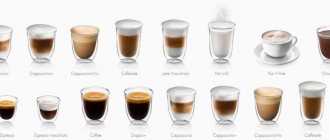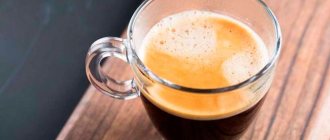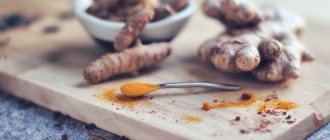Historical roots
According to Wikipedia, cappuccino (or cappuccino) translated from Italian cappuccino means capuchin. Therefore, the origin of the name of the coffee drink is associated with Europe in the 17th century, where the monastic Order of the Capuchins existed. Moreover, the capuchin was not only part of the name of the order, but also a designation for the characteristic red-brown color of monastic robes. A little later, in the 18th century, due to the similarity of color, this began to be called a drink made from coffee, egg yolks and cream, which began to be prepared in Austria (the German version is Kapuziner). At the same time, the Italian form of the name of the drink - cappuccino - was recorded only in the 20th century.
These are the vague posts the world library gives: cappuccino was born in Italy in the 17th century thanks to the Capuchin Order, it was drunk and prepared in Austria since the 18th century, but in Italy they began to write about it only in the 20th. Maybe, of course, I don’t understand something... Let’s return to the Italian specialists who, in the coffee trilogy, gave a picture that characterizes cappuccino.
The Bazzara brothers believe that according to the Italian tradition, to prepare a cappuccino it is necessary to: prepare a standard 25 to 30 ml espresso in a cup with a volume of 150 to 200 ml, then froth 100 to 140 ml of fresh whole milk so that equal parts of liquid get into the cup phase of milk and its foam, pour the resulting substance into a cup of espresso.
How to make cappuccino
The birthplace of the drink is, again, Italy. It consists of equal parts espresso, milk and thick milk foam. Externally, the foam resembles a fluffy hat worn by Italian Capuchin monks in the Middle Ages. She gave the drink the name “cappuccino”.
To prepare one 180 ml serving you will need 200 ml of cold pasteurized milk (3-3.5% fat), 7-10 g of ground coffee and 25-35 ml of water. For decoration you can use grated chocolate, cocoa or cinnamon.
- First, whisk the milk until foam forms. To do this, you can use a special steam tap in a coffee machine - a cappuccino maker. If you don’t have a coffee machine, then a blender, mixer or a special small whisk will do.
- Next, brew the espresso and pour it into a cappuccino cup.
- Then carefully pour in the frothed milk, carefully holding the foam
- The last stage is laying out the top layer of foam. Finally, sprinkle the drink with grated chocolate or cocoa.
The traditional cappuccino recipe does not involve adding sugar - it is believed that the drink is already quite sweet thanks to milk. The cappuccino temperature should be around 60–70 °C before serving.
Ingredients
Italian experts believe that the ideal amount of espresso is 25 ml: if the espresso is too “short” (not enough), then the aromas will not fully develop, and if it is too “long” (too much), then they will dissipate. It is ideal to use fresh whole cow's milk, which has the right organoleptic qualities and can produce a velvety foam.
Discussions about the properties of milk in relation to the foam obtained from it, with a mention of the Institute of Chemistry and Milk Technology in Kiel (Germany), were given in one of his posts with discussions about latte.
Coffee varieties for cappuccino: classification
There are more than 70 species of coffee trees growing on the planet. But only 3 of them are used for preparing various drinks. These are Arabica, Liberica, Robusta. This method of product classification began to be used back in the 18th century.
Arabica coffee is considered the most valuable type of coffee. The product is famous for its taste and aroma qualities. Such trees grow in a number of countries located on different continents. To a large extent, it is the location that determines the taste characteristics of the fruit.
Arabica is extremely popular. This is an excellent variety of coffee for cappuccino, espresso, Americano and other drinks. But there is another factor that forms a high degree of its value. This is difficult to grow. The variety is capricious, susceptible to temperature changes, and afraid of pests and diseases. Therefore, prices for Arabica are always the highest.
In second place is Robusta. In comparison with Arabica, this variety loses in taste and aromatic qualities. But robusta has other advantages: this coffee is less finicky in terms of cultivation and surpasses the leader in strength. And although it is less demanded in industry as a percentage, it is successfully used for the preparation of soluble products.
Preparation
Preparing cappuccino should begin by frothing cold milk, which will immediately heat up during the process. Once the foaming is complete and the milk is still in the pitcher (not to be confused with the baseball player), the espresso is made. When everything is ready, the milk emulsion is poured into a cup of espresso.
In cafeterias, you can often see how the barista takes milk out of the refrigerator already in the pitcher. Apparently, milk stored in this way does not gain extra degrees when poured into a milk jug at room temperature.
Serving ready cappuccino
The ideal option for serving cappuccino is pre-heated ceramic tulip-shaped cups with thick walls. If you use cold dishes, then when you prepare the cappuccino it will cool faster, giving up some of its temperature to heat the cup. The drink will not turn out the way you would like.
Are you learning to make cappuccino at home and don’t have special cups yet? It's okay, use the dishes you have.
Cappuccino is a quick drink and should be drunk immediately after preparation. After 20 minutes the milk cools down and the top foam loses its taste.
Coffee to milk ratio
Due to inexperience, the old rule of thumb for making cappuccino, known as the drink of thirds, is often misinterpreted. In fact, the wording is also translated as a drink of three parts, meaning that cappuccino consists of three equal parts: coffee, hot milk and foam.
In order not to get confused and not to break the “golden” rule, I will give the proportions generally accepted by Italians: 1/5 espresso coffee, 2/5 hot milk and 2/5 micro-foam. This ratio is confirmed by familiar figures: 25 ml espresso + 100 ml milk with foam = 125 ml of finished drink. And 25 ml is 1/5 of 125 ml. Eureka!
How to make a latte
As with cappuccino, a latte requires espresso coffee and cold milk. The differences from cappuccino are in the preparation recipe and the method of serving.
To get a 250 ml latte you will need 300 ml of cold pasteurized milk, 7-10 g of ground coffee and 25-35 ml of water.
- Foaming cold milk
- Brewing espresso
- Pour the frothed milk into an Irish glass or a regular clear glass glass. Add brewed espresso here. At this stage, the main thing is not to mix the ingredients. After just 2 minutes, the drink will begin to separate - the milk will be at the bottom, the espresso will be in the middle, and the thick milk foam will float to the top.
The classic recipe can be varied - for example, you can prepare a drink with the addition of various toppings and syrups. The main thing is to follow a simple rule: the amount of fruit additives should not exceed 10 ml per 250 ml mug. Then they will only slightly highlight the drink, preserving and emphasizing the aroma and taste of coffee.
Appearance
Cappuccino is served in a pre-heated white porcelain cup with a capacity of 150 to 180 ml. The drink should have a glossy white foam with a smooth, silky texture, without large bubbles, reminiscent of liquid cream.
In addition, the foam should be decorated with the characteristic “ring” of espresso. Apparently, its width and smooth outline depend on the barista’s ability and desire to provide aesthetic pleasure.
How much does it cost to service a coffee machine?
The user is involved in the long-term performance of the coffee machine. Yes, it is you who determine the service life of your coffee machine. The quality of service determines the service life. But you're probably wondering how much it costs. Using Jura coffee machines as an example, we will need two concepts, cleaning from oils (clean) and limescale (descale). These two concepts are the monetary component of servicing a coffee machine.
To maintain coffee machines, there are coffee machine care chemicals on the market. The first, a chemical composition in the form of tablets, is designed to remove coffee oils. The cost of such tablets is 900 rubles for 6 tablets . The coffee machine itself will tell you when to clean it. According to the regulations, the manufacturer programmed this type of cleaning every 180 cups of brewed coffee. This means that every two months you need to use one tablet (clean). Total 75 rubles per month.
………. continuation (part 3)
How to whip up foam with a cappuccino maker in a professional coffee machine
A cappuccino maker can be compared to a kind of mixer. A special device will help you achieve perfect foam in a minimum amount of time.
To create foam with a cappuccino maker in a coffee machine, you will also need a pitcher.
First, let's figure out what these words actually mean.
So:
- cappuccino maker is a special container used to prepare espresso-based coffee drinks. Today you can find any suitable shapes and dimensions. To get perfectly whipped foam and milk product, during the preparation process a cappuccino maker is connected to the steam wand of the coffee machine;
- pitcher – a special container for whipping cream. The manufacturing material is glass, ceramics, metal or durable food-grade plastic. An important criterion when choosing a material is its heat-conducting properties. In this case, you can ensure not only high-quality whipping, but also independent control of the optimal temperature regime.
Important! Give preference not only to high-quality, but also safe materials. Otherwise, under the influence of high temperatures, low-quality materials will release toxic substances into the milk, which will spoil the taste of the drink and may be harmful to health.
Simple, step-by-step instructions will help you achieve the perfect whipped foam:
- Pour milk with a high percentage of fat into the pitcher so that the liquid level does not reach the level of the spout;
- Lower the whisk of the cappuccino maker into the pitcher 1 cm at an angle of 45 degrees. Make sure that the whisk is in contact with the wall of the container;
- set the steam mode in the coffee machine. To better control the temperature of the dairy product, hold the bottom of the pitcher. The milk should sizzle and swirl throughout the whisking time;
- The cappuccino maker will go down as the foam is whipped;
- the bottom of the pitcher should become warm, as soon as this happens we move on to the next point;
- dip the cappuccino maker until the milk rotates but does not make a hissing sound;
- The temperature should reach 70 degrees. As soon as the bottom becomes hot, turn off the steam;
- Gently mix the finished product, then hit the cup on the table for the final chord.
For you:
Coffee and amaretto: 7 best recipes
How to make foam at home
Not all coffee gourmets have a cappuccino maker and coffee machine lying around at home. To be more precise, probably not a single one. How to be in this case? Don’t rush to get upset and run to the nearest coffee shop. You can make the perfect cappuccino yourself, using simple equipment or improvised means.
Blender
To make cappuccino foam using a blender, pour full-fat milk into a small saucepan or measuring cup, based on the calculation for one serving.
Important! The volume of the dairy product should not exceed ½ container.
Next, follow the instructions:
- Heat the milk over low heat (both a microwave and a stove will do);
- As soon as steam appears above the milk, remove from heat;
- then arm yourself with a blender and start whipping hot milk;
- It is necessary to finish whipping when the foam reaches the correct, dense consistency.
French press
The main purpose of a French press is to brew tea and coffee. The mechanism is quite simple, it consists of a glass flask with a metal piston that holds tea leaves and ground coffee below.
To prepare cappuccino, fill the flask with milk to a third of the total volume, and carefully work the piston.
Important! When whipping, be careful and extremely careful; the flask is quite fragile and can break or burst with sudden movement.
If bubbles appear in the milk, continue whisking it until foamy. Smoothly rotate the piston clockwise. Don't forget to constantly tap the flask on the table. As soon as the foam becomes thick enough, stop and add to the cappuccino.
With a fork
If you don’t have any utensils at hand, you’ll definitely have a dinner fork. You can even use it to create cappuccino foam.
Follow these simple steps:
- pour hot milk into a deep container;
- tilt the container and simply whisk the milk with a fork in quick circular movements;
- Remember, choosing this method will require hard work. The beating process will take at least 1.5-2 minutes. In addition, you are unlikely to be able to achieve ideal strength and fluffiness, but you will definitely get just beautiful and tasty foam.
For you:
Making coffee in a carob coffee maker: features of the process
Mixer
Whipping milk with a mixer is one of the simplest and most effective ways. Pour the milk product into a suitable enamel container, place it on low heat, and immediately begin whisking at the highest speed.
There is no need to bring the milk to a boil; as soon as foam starts to appear, remove the bowl from the heat. Pour into the finished cappuccino immediately, while hot.











